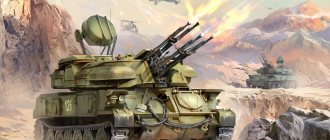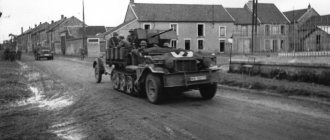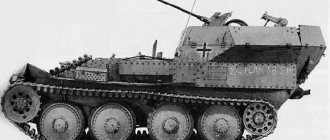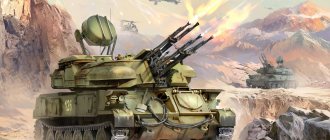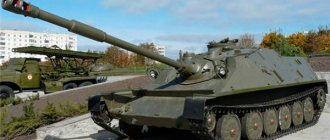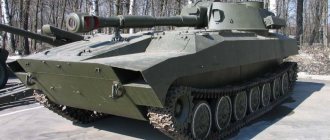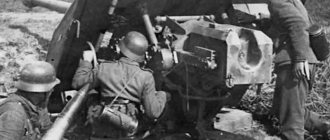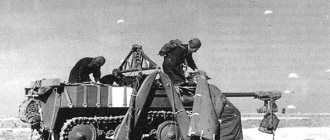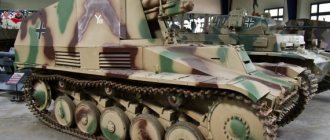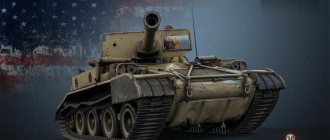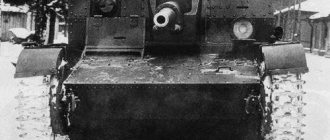The M163 Vulcan self-propelled anti-aircraft gun (Vulcan Air Defense System) is a US-made air defense system. It was developed to provide air defense to units located on the front line and to combat low-flying air targets. The M163 Vulcan, together with the MIM-72 Chaparral air defense system, formed the backbone of the air defense of tank divisions.
Story
The installation has been created by the Rock Island Arsenal since 1964. The Vulcan is an anti-aircraft gun, based on an aircraft 20-mm cannon, mounted on the chassis of an M113 armored personnel carrier. General Electric began serial production of the M163 Vulcan in 1967, producing almost 700 units.
Beginning to enter service with the United States military in 1969, the Vulcan was actively used by American troops in the Vietnam and Lebanon wars, battles in Western Sahara and other armed conflicts.
Vulcan at the American training center in California. 1988
Today, the Vulcan remains in service in a number of countries around the world.
M163
| M163 | |
| US Army M163, 1988 | |
| 20mm Self-Propelled Air Defense Gun M163A1 | |
| Classification | self-propelled anti-aircraft gun |
| Combat weight, t | 12,5 |
| Crew, people | 4 |
| Story | |
| Manufacturer | cm . manufacturers |
| Years of production | 1967—n/a |
| Years of use | since 1969 |
| Number of issued, pcs. | 671 |
| Basic operators | |
| Dimensions | |
| Case length, mm | 4864 |
| Width, mm | 2855 |
| Height, mm | 2921, total |
| Ground clearance, mm | 410 |
| Booking | |
| Armor type | aluminum rolled |
| Body forehead (top), mm/deg. | 38 / 45° |
| Body forehead (bottom), mm/deg. | 38 / 30° |
| Hull side (top), mm/deg. | 44 / 0° |
| Hull side (bottom), mm/deg. | 32 / 0° |
| Hull feed, mm/deg. | 38 / 8—9° |
| Bottom, mm | 29 |
| Housing roof, mm | 38 |
| Turret front, mm/deg. | not armored |
| Tower side, mm/deg. | not armored |
| Tower feed, mm/deg. | not armored |
| Tower roof, mm/deg. | not armored |
| Armament | |
| Caliber and brand of gun | 20 mm M61 |
| Gun type | rifled automatic six-barrel |
| Gun ammunition | 2100 |
| Angles VN, degrees. | −5…+80 |
| Firing range, km | 1,5 |
| Sights | automatic anti-aircraft M61 with radar guidance, night AN/TVS-2B , telescopic M134 |
| Mobility | |
| engine's type | V-shaped 6-cylinder two-stroke diesel liquid cooled |
| Engine power, l. With. | 212 |
| Highway speed, km/h | 64 |
| Cruising range over rough terrain, km | 480 |
| Specific power, l. s./t | 17,0 |
| Suspension type | individual torsion bar, with hydraulic shock absorbers |
| Climbability, degrees. | 30 |
| Wall to be overcome, m | 0,61 |
| Ditch to be overcome, m | 1,68 |
| Fordability, m | floats |
| Media files on Wikimedia Commons | |
M163 20mm self-propelled anti-aircraft gun
(eng. 20mm Self-Propelled Air Defense Gun M163), also known as
the Vulcan Air Defense System
, was a US self-propelled anti-aircraft gun from the 1960s.
It was created by the Rock Island Arsenal in 1964-1965 by installing an anti-aircraft gun, developed on the basis of an aircraft 20-mm cannon, on the chassis of an M113 armored personnel carrier. The AN/VPS-2[en] guidance station is mounted on the ZSU turret, coupled with an anti-aircraft gun. Serial production of the M163 was carried out by General Electric (later the branch responsible for the production and routine maintenance of the units was acquired by General Dynamics) and several associated contractors since 1967, a total of 671 SPAAGs of this type were produced. The program of work to modernize and extend the service life of installations in the military ( Product Improved Vulcan Air Defense System
, abbr.
PIVADS
) was implemented by Lockheed Electronics[1].
The M163 began entering US troops in 1969 and, together with the MIM-72 air defense system, formed the basis of the air defense of tank divisions. The M163 was used by US troops in the Vietnam War, but was withdrawn from US service in the 1980s due to obsolescence. The M163 was extensively exported and used by Israel in the Yom Kippur War and Lebanon War, and by Morocco in the Western Sahara War. As of 2010, the M163 still remains in service in a number of countries.
Peculiarities
The Vulcan's hull is made of welded aluminum armor sheets up to 38 mm thick. Such armor can provide protection for the vehicle’s crew from small arms fire and fragments of mines or artillery shells. The only difference from the hull of a standard M113 armored personnel carrier is the presence of additional panels that serve for protection and also provide buoyancy for the installation and are located on the upper frontal plate and along the sides.
The Vulcan's powerplant is a Detroit Diesel 6V53 two-stroke six-cylinder liquid-cooled diesel engine producing 158 kW at 2800 rpm. It provides the ability to travel on paved roads at speeds of more than 65 km/h. The chassis includes rubber-coated large-diameter road wheels (five rollers on each side), front drive wheels and rear idler wheels. The upper branch of the tracks is protected by steel anti-cumulative screens.
Movement by swimming is carried out by rewinding the tracks, allowing you to reach speeds of up to 6 km/h. Before crossing a water barrier, the wave deflector flap is installed in the working position, tilting forward, and the water pumps are turned on.
The vehicle is equipped with a night vision device, located at the driver’s workplace and allowing traffic control in conditions of limited visibility.
The greatest effectiveness in creating a combat area air defense system was achieved with the combined deployment of M163 Vulcan and MIM-72 Chaparral units at a distance of 1000 m from each other. Such a mixed anti-aircraft division was able to cover parts of the division over a total area of up to 100 km2.
Armament
The M163 Vulcan is armed with a 20 mm automatic six-barrel M61A1 Vulcan cannon housed in an open-top rotating turret with an armor shield on the rear hemisphere to protect the gunner. On the right side of the tower there is an AN/VPS-2 radar rangefinder.
The gun is aimed in a vertical plane in the angle range from –5° to +80° using high-speed electric drives or, in case of automatic failure, manual guidance mechanisms. The gun barrel block is also controlled by an electric drive. Special mechanisms regulate the rate of fire and the duration of the burst - 10, 30, 60 or 100 shots. The ammunition supply is linkless.
For firing, ammunition is used with armor-piercing tracer and fragmentation incendiary projectiles M53, M54, M55A2, M56A3, M220 and M242 weighing 0.2 kg and with an initial flight speed of 1250 m/s. The gun's rate of fire can reach 3,000 rounds per minute, and its ammunition capacity is 2,280 rounds: 1,180 in full combat readiness and 1,100 in reserve. The effective firing ceiling is 800–1500 m. The ballistic firing range is 7.5 km.
The M163 Vulcan's fire control system consists of a gyro-stabilized sight with a Mk. 20 Mod 0 and AN/VPS-2 rangefinder radar with a working range of up to 5 km and measurement accuracy of ±10 m.
If target designation is carried out via radio communication, the target is targeted visually, after which it is captured for further tracking by an optical sight, which, in turn, orients the radar antenna towards it.
Using FAAR system radar data, the installation can fire at targets flying at an altitude of up to 1500 m at a speed of up to 300 m/s. Firing to kill is carried out both in single shots and in short or long bursts at a distance of up to 2000 m. When firing at air targets, the rate of fire is set to 3000 rounds per minute, for ground targets - 1000 rounds per minute.
Anti-aircraft self-propelled gun SMC Vulcan Wheeled Carrier (USA)
The development of tactical aviation and aviation weapons has always placed new demands on military air defense. The armies needed more and more anti-aircraft self-propelled guns, but promising models were not always able to enter service. An example of such a development, which performed well in tests, but did not end up in service with the troops, is the American cannon-armed self-propelled gun Vulcan Wheeled Carrier from the Standard Manufacturing Company.
At the turn of the seventies and eighties, one of the main elements of the military air defense of the American army was the M163 self-propelled anti-aircraft gun, built on the basis of the M113 armored personnel carrier and armed with a six-barreled 20-mm M61 Vulcan cannon. Such a combat vehicle, created back in the mid-sixties, no longer fully met modern requirements. In particular, the military wanted to obtain a self-propelled gun with higher mobility and maneuverability on all terrains.
The Vulcan Wheeled Carrier self-propelled gun is being tested. Photo Ftr.wot-news.com
A new version of a combat vehicle for military air defense was proposed in the early eighties by the Standard Manufacturing Company (SMC) from Dallas, PC. Texas. Shortly before this, SMC designers formed the appearance of a promising multi-purpose chassis with increased cross-country ability, which could be used in the construction of a wide variety of military and civilian equipment. In the shortest possible time, the company worked on several preliminary projects. It was planned to offer the potential customer the chassis itself, transport vehicles based on it, and several samples with one or another weapon.
In accordance with the fundamental decision of the developers, the first step was to implement the project of an anti-aircraft self-propelled gun on a promising chassis. Such a vehicle, having shown itself well at the training ground, could not only get into the troops, but also pave the way for other standardized models. Design work on the new ZSU started no later than 1980-82.
SMC specialists decided that the promising self-propelled gun should carry the same weapons as the existing M163 vehicles. The presence of the M61 Vulcan gun was reflected in the project designation. The ZSU was named Vulcan Wheeled Carrier (VWC) - “Vulcan Wheeled Carrier”. Subsequently, the only prototype of this machine was given its own name Excalibur.
Together with the existing weapon, the project planned to use the most daring and new ideas aimed at obtaining the best possible characteristics. It should be noted that this approach ultimately led to very remarkable results. The finished machine differed from other equipment not only in the special design of individual units, but also in its recognizable appearance. With all its specific problems, the SMC VWC self-propelled gun had a futuristic exterior and looked like some kind of piece of equipment from a science fiction work.
The self-propelled gun moves through sandy terrain. Photo Ftr.wot-news.com
The designers of the Standard Manufacturing Company, using a number of original ideas, created a four-axle wheeled combat vehicle with a distinctive crew cabin and a large cargo platform suitable for mounting special equipment. In the Vulcan Wheeled Carrier project, the platform was intended to accommodate a fully rotating combat module with an automatic cannon. From the point of view of general architecture, the new model of military equipment differed little from some other developments of that time.
The main unit of the promising chassis was the body of a fairly simple design. According to available data, the VWC prototype was not equipped with armor and was made only of structural steel and other materials. In the front part of the hull there was a large cabin of a non-standard design, and behind it were the engine compartment and volumes for installing the transmission. A small fighting compartment was located behind the engine, containing some elements of the turret and the gunner's workplace.
Probably due to the experimental nature of the project, the new type of ZSU received only a partially closed cabin located in the front part of the hull. The volume for the crew was formed by a pair of inclined bottom sheets connected to low sides and a horizontal bottom. The upper frontal parts were missing; instead of them there was a pair of posts to which a light lattice roof was attached. There was no glazing at all, which, however, simplified boarding and disembarking.
The main part of the hull had a rectangular cross-section with bevels at the bottom. Directly behind the cabin was placed a lightweight power plant casing with mesh inserts, behind which was a cylindrical unit with a turret ring. At the stern there was a large rectangular hull with a hinged rear wall. Large shelves were installed along the sides, serving as wings.
The promising chassis was equipped with an eight-cylinder V-shaped diesel engine of the Detroid Diesel brand, which developed power up to 135 hp. To save volume, a hydromechanical transmission was used inside the body, distributing torque to all eight drive wheels. It was this kind of transmission that allowed the designers to reduce the height of the car while obtaining all the desired capabilities. In other words, the internal components of the chassis associated with the chassis did not interfere with the installed combat module.
View of the starboard side and stern. You can consider the tower units. Photo Ftr.wot-news.com
In the new chassis family, Standard Manufacturing Company engineers used the original chassis architecture, which received the working name Trailing Arm Drive. On each side of the Vulcan Wheeled Carrier hull it was proposed to install four wheels on a TAD type suspension. The main element of this design was a rear-facing balancer, reminiscent of a torsion bar suspension device. It was proposed to movably attach one end of the balancer to the body, and a wheel was mounted on the second. A spring connected to the balancer arm was installed on top, with some tilt forward. When loaded, it worked in tension.
The balancer of the TAD system differed from similar devices in its increased dimensions and was actually a hollow beam. Inside the balancer, at its ends, there were two gears connected by a chain drive. The suspension unit of the balancer to the body included a shaft from the final drive of the transmission, through which power was supplied to one gear, then to the chain, the second gear and from it to the wheel. For all its complexity, this design of the chassis combined all-wheel drive and high cross-country ability provided by the large stroke of the balancers.
The chassis received suspension controls. Depending on the terrain, the mechanic driver could change the ground clearance. Swinging balancers with springs changed this parameter in the range from 10 to 22 inches (254-559 mm). Despite the change in ground clearance, the suspension “worked out” any uneven terrain in all conditions.
At the design stage, it became clear that the recoil of the M61 gun did not correspond to the characteristics of the new chassis. In this regard, it was necessary to abandon shooting on the move and equip the combat vehicle with jacks. Three hydraulic outriggers with round supports are located in the front part of the cabin and on the sides of the aft hull sheet. During combat work, the supports lay on the ground and took on the weight of the vehicle. In the retracted position, the front round support went into the niche of the lower frontal sheet, and the stern ones were located under the rear bumper.
The driver and commander of the ZSU had to be in a two-seat, semi-open front cabin. Their workplaces had no protection and were not even equipped with glazing. Only the lattice roof overhead protected them from some external influences. The left workplace of the cabin was intended for the driver, the right - for the commander. It was proposed to enter the cabin through large openings between the wings of the front wheels and the roof. Between the two workstations there was a hydraulic cylinder for the front jack.
Diagram of the Trailing Arm Drive type chassis connected to the onboard power distribution. Patent drawing
On the rear cargo platform of the vehicle, using a special ring with shoulder straps, it was proposed to install a combat module with anti-aircraft weapons. The SMC VWC project included the use of an original rotating turret, partly based on the units of the existing M163 ZSU. This unification to a certain extent simplified the assembly of the prototype, and was also supposed to help in the further operation of the equipment.
Directly on the chase there was an asymmetrical horizontal platform with mounts for various devices. In front of the platform, on the longitudinal axis, a swinging installation with a 20-mm M61 six-barreled gun was placed. The relatively heavy weapon was mounted on a durable frame with spring balancing devices. Electric vertical guidance drives were used, backed up by manual mechanisms.
The left side of the platform was given over to the installation of a large box for ammunition. Due to the high rate of fire of the Vulcan cannon, the combat vehicle needed large ammunition and a box for it, distinguished by the appropriate dimensions. It is curious that the outer wall of the large box provided additional protection for the gunner and completely protected him from attacks from the left.
Guidance equipment was placed on the starboard side. Based on operating experience with M163 self-propelled guns, the new VWC was equipped with an AN/VPS-2 guidance radar. The antenna of this station was placed on its own stand with vertical guidance drives. The antenna movements were carried out synchronously with the vertical aiming of the gun. Various elements of the radar and other instruments were placed in boxes at the rear of the platform. Data from the locator was transmitted to a computing device that automatically controlled the gunner's sight.
In the center of the rotating turret there was a gunner's workplace. He could freely observe the surrounding air situation “over the side”, aim the gun and open fire if necessary. In combat work he was helped by the available means of automation and mechanization.
ZSU on rough terrain. Photo: Yuripasholok.livejournal.com
Despite the lack of armor and the maximum lightweight design, the promising anti-aircraft self-propelled gun SMC Vulcan Wheeled Carrier was not the most compact and light. The total length of the vehicle reached 5.5-6 m, width - about 2-2.5 m. Due to the special design of the chassis, it was possible to reduce the size of the frontal projection. The total height of the vehicle, taking into account anti-aircraft weapons (in the stowed position) did not exceed 2.2-2.5 m. The combat weight reached 16 thousand pounds (7.26 tons).
In 1982-83, Standard Manufacturing built the first and, as it turned out, the only prototype of a new type of ZSU. Moreover, as far as is known, it was the only real machine built within the entire family of projects. Other prototypes on a unified or similar chassis were not built or tested.
An experienced anti-aircraft self-propelled gun with its own name Excalibur entered the training ground and showed all its capabilities in the shortest possible time. For obvious reasons, the testers were primarily interested in the parameters and potential of the original chassis. The vehicle was equipped with a fairly old weapon, and its parameters had long been established. However, during one of the testing stages it was necessary to check the interaction of a fairly powerful gun with a chassis of an unusual design.
During sea trials, it was found that the fully equipped ZSU is capable of reaching speeds of up to 45 mph (more than 70 km/h) on the highway. Power reserve is up to several hundred kilometers. Mobility parameters in different landscapes were also determined. Suspension with a large stroke of balancers and low-pressure wheels allowed the self-propelled gun to move on soft soils and snow, as well as climb steep slopes. According to known data, in terms of mobility, the chassis with units of the Trailing Arm Drive type was at least not inferior to other wheeled vehicles.
Before firing, the Excalibur vehicle had to be hung on jacks, which to some extent reduced its real combat potential. At the same time, regardless of the pointing angles, the self-propelled gun maintained an acceptable position and behaved quite stable. From the point of view of combat use, the SMC VWC ZSU differed little from the serial M163.
Various variants of equipment based on a promising chassis. Patent drawingsOverall, the two cars turned out to be worthy rivals for each other. In some respects, the new wheeled self-propelled gun was ahead of its tracked predecessor, but in others it was behind it. The obvious advantages of the promising model were improved mobility characteristics, regardless of terrain. Also, the wheeled chassis was easier to operate and cheaper to produce. But at the same time, the new vehicle was distinguished by the lack of any protection and limited combat capabilities.
In the mid-eighties, a prototype of the Vulcan Wheeled Carrier with its own name Excalibur was shown to representatives of the American military department, and they determined the future of the original project. The new anti-aircraft self-propelled gun was considered unsuitable for adoption. Several positive features and advantages provided by design innovations could not outweigh the whole set of disadvantages.
The most notable problem with the SMC VWC project was the lack of any protection for the crew. People had no protection not only from bullets and shrapnel, but even from wind and rain. For this reason alone, the vehicle was not of particular interest to the troops. The new design of the chassis, for all its advantages, turned out to be very difficult to manufacture and operate, and in this regard it was inferior to other wheeled vehicles. Placing a separate gear inside the balancer made servicing difficult, and the open installation of the springs led to some risks.
Another serious problem was the weapons used. The M163 self-propelled gun, equipped with a 20-mm automatic cannon with radar guidance, was no longer suitable for the military by that time. The army did not need a new vehicle with similar equipment, which did not have any advantages over the existing model.
Other versions of combat and special vehicles. Patent drawingsAfter this decision by the military, work on the Vulcan Wheeled Carrier project stopped. The only prototype built went into the sump. Subsequently, the combat module with weapons and equipment was removed from it. Over time, the remaining chassis was partially dismantled. Open-air storage is bad for any vehicle, and the SMC VWC self-propelled gun was no exception. The unique car is still rusting and waiting to be sent for restoration or melting down.
It should be recalled that the anti-aircraft self-propelled gun was created by engineers of the Standard Manufacturing Company with the aim of promoting a new chassis design and a whole family of equipment built on its basis. As work on the VWC topic progressed, the designers were developing the proposed chassis and working on the creation of new models for various purposes. The possibility of using the chassis in different roles was studied, and in addition, improvements to its design were proposed.
All the main developments on the topic of promising chassis became the subject of patents. In total, SMC received a dozen such documents confirming its rights to the original ideas. The patents provided alternative TAD suspension options. In particular, the possibility of using it together with an on-board transmission with power distribution through chain drives was considered. The possibility of installing a spring with different angles and placing an additional shock absorber inside it was also explored.
Based on the chassis of one or another version, it would be possible to build a variety of transport vehicles for people and cargo, both armored and unprotected. The chassis could become a carrier of anti-aircraft weapons in the form of guns or missiles, anti-tank guided systems, etc. In general, multi-axle vehicles with a gross weight of up to 8-10 tons could find application in a variety of areas and have a significant impact on the development of the US Army fleet.
The forgotten and abandoned “Vulcan Wheel Carrier”. Photo: Yuripasholok.livejournal.com
According to the plans of the early eighties, new developments should have been promoted with the help of an anti-aircraft self-propelled gun of an unusual appearance. This machine, having coped with the main tests, failed to receive positive ratings from a potential customer. As a result, it was abandoned, and soon SMC had to curtail work on the entire topic of new chassis, since they now had no prospects.
To get into the troops, a new model of military equipment must not only show high performance, but also meet a number of different requirements. The promising Vulcan Wheeled Carrier project from Standard Manufacturing Company did not meet the basic requirements of a potential customer, which led to its closure. The curious project of an anti-aircraft self-propelled gun of a specific appearance remained a striking but meaningless episode in the history of American military equipment.
Based on materials from: https://ftr.wot-news.com/ https://secretprojects.co.uk/ https://tank-net.com/ https://strangernn.livejournal.com/ https://shushpanzer -ru.livejournal.com/ https://patents.google.com/patent/US4600069A/
Modernization
Since 1984, some of the army's M163 Vulcan installations have undergone modernization in accordance with the PIVADS program, which provides for the improvement of the air defense system. In order to improve the fire control system, in particular, the radar was modernized. At the same time, the radio range finder was able to not only measure the range to the target, but also automatically track the target both in range and in angular coordinates.
Anti-aircraft self-propelled gun M163 Vulcan on the march. 1992
As part of the modernization program, a helmet-mounted sighting device was developed for the gunner, with the help of which the radar antenna began to focus on the observed target for its further tracking, and the use of new armor-piercing shells with a detachable tray made it possible to increase the effective firing range to 2600 m.
Insufficient firing range, the lack of an armored turret, the impossibility of all-weather use and some other shortcomings were the reason why the Vulcan began to be replaced by the M247 Sergeant York installations in the US ground forces.

